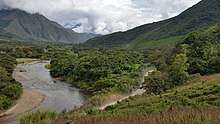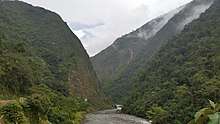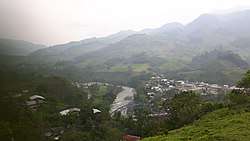Huancabamba River
The Huancabamba River ("Stony Plain" in the Quechua language) in the Pasco Region of Peru has its origin in the confluence of several small rivers near the town of Oxapampa: the Chontabamba, the Llamaquizú, and the Esperanza rivers. From an elevation of 1,807 metres (5,928 ft) at Oxapampa, the Huancabamba River runs northward for approximately 77 kilometres (48 mi) by road paralleling the river to the village of Pozuzo. the Huancabamba is joined by the Santa Cruz River 4 kilometres (2.5 mi) north of Pozuzo at an elevation of 700 metres (2,300 ft) and thereafter is called the Pozuzo River.[1] In its lower course the Pozuzó is called the Pachitea River which joins the Ucayali River, a major component in the Amazon River drainage basin.[2][3]



The Huancabamba has a turbulent course, dropping in elevation from 1,805 metres (5,922 ft) at Oxapama to 707 metres (2,320 ft) at its junction with the Santa Cruz River below Pozuzo. It runs in steep canyons for part of its course and with mountains either side of the river rising to more than 3,000 metres (9,800 ft) in elevation. A few kilometres of the river above Pozuzo is within the Yanachaga–Chemillén National Park.[4] The river is located in the ecological zone of the Peruvian Yungas, or Ceja de Selva ("eyebrow of the jungle"), the transition zone between the low jungles of the Amazon Basin and the Andes highlands.[5]
Footnotes
- Townsend-Small, Amy; Noguera, Jorge L.; McClain, Michael E.; Brandes, Jay A. (June 2007). "Radiocarbon and stable geochemistry of organic matter in the Amazon Headwaters, Peruvian Andes". Global Biogeochemical Cycles. 21: 3.
- "Areas and Hydrographic Basins of Latin America". F.A.O. Retrieved 16 June 2020.
- Google Earth
- Google Earth
- The Nature Conservancy (2006). Planificacion para la Conservacion Ecoregional de las Yungas Peruanas. Peru: Facultad de Ciencias Forestales, Universidad Nacional Agraria La Molina.